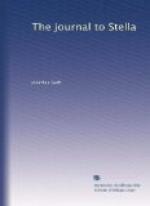Letter 56.
1 Addressed to “Mrs. Dingley,” etc. Endorsed “Decr. 18.”
2 Vengeance.
3 Charles Connor, scholar of Trinity College, Dublin, who took his B.A. degree in the same year as Swift (1686), and his M.A. degree in 1691.
4 The History of the Peace of Utrecht.
5 See Letter 55, note 7.
6 Lord Oxford’s daughter Elizabeth married, on Dec. 16, 1712, Peregrine Hyde, Marquis of Caermarthen, afterwards third Duke of Leeds (see Letter 42, note 23 and Letter 24, note 5). She died on Nov. 20, 1713, a few days after the birth of a son. Swift called her “a friend I extremely loved.”
7 “Is” (Ms.).
8 Disorders.
9 See Letter 34, note 10.
10 John Francis, Rector of St. Mary’s, Dublin, was made Dean of Leighlin in 1705.
11 See Letter 9, note 7.
12 Possibly “have.”
13 See Letter 55, notes 9, 10, 11.
14 This clause is omitted by Mr. Ryland.
15 See Letter 31, note 6.
16 See Letter 54, Oct. 30, 1712.
17 Thomas Jones, Esq., was M.P. for Trim in the Parliament of 1713-4.
18 A Dutch agent employed in the negotiations with Lewis xiv.
19 When I come home.
Letter 57.
1 Addressed to “Mrs. Dingley,” etc. Endorsed “Jan. 13.”
2 “Ay, marry, this is something like.” The earlier editions give, “How agreeable it is in a morning.” The words in the Ms. are partially obliterated.
3 In this letter (Dec. 20, 1712) Swift paid many compliments to the Duchess of Ormond (see Letter 17, note 5): “All the accomplishments of your mind and person are so deeply printed in the heart, and represent you so lively to my imagination, that I should take it for a high affront if you believed it in the power of colours to refresh my memory.”
4 Tisdall’s Conduct of the Dissenters in Ireland (see Letter 61, note 7).
5 See Letter 9, note 20 and Letter 20, Apr. 13, 1711.
6 Monteleon.
7 See Letter 5, note 8 and Letter 3, note 3.
8 Utrecht, North and South Holland, and West Frieseland.
9 See Letter 46, note 11.
10 See Letter 46, note 11.
11 “On Queen Anne’s Peace.”
12 See Letter 43, note 11. The poem was “Dryades, or the Nymph’s Prophecy.”
13 See Letter 35, note 4.
14 See Letter 17, note 3.
15 Dr. Tobias Pullen (1648-1713) was made Bishop of Dromore in 1695.
16 Lord Charles Douglas, Earl of Selkirk, died unmarried in 1739. When his father, William, first Earl of Selkirk, married Anne, Duchess of Hamilton, the Duchess obtained for her husband, in 1660, the title of Duke of Hamilton, for life. James ii. conferred the Earldom of Selkirk on his Grace’s second and younger sons, primogenitively; and the second son having died without issue, the third, Charles, became Earl. The fifth son, George, was created Earl of Orkney (see Letter 52, note 5). The difference between Lord Selkirk and the Earl of Abercorn (see Letter 10, note 33) to which Swift alludes was in connection with the claim to the Dukedom of Chatelherault (see Letter 43, note 32).




